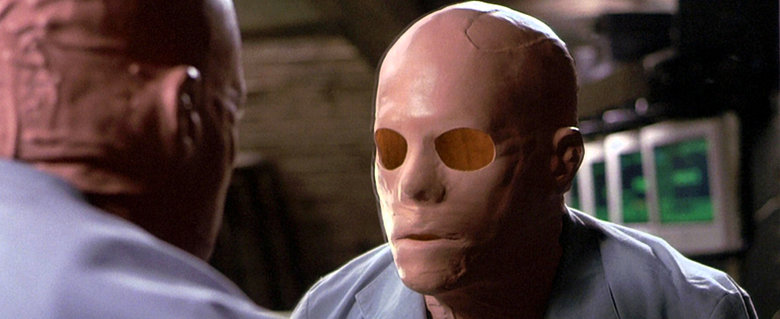“Hollow Man” is one of the nastiest big-budget movies ever made in the Hollywood studio system, and considering that the director is Paul Verhoeven, the filmmaker behind the original “RoboCop” and “Total Recall,” “Basic Instinct” and “Showgirls,” that’s saying a lot.
Kevin Bacon plays Sebastian Caine, a scientist heading up a top-secret project that aims to make invisibility possible; Caine’s team includes his ex-girlfriend Linda McKay (Elisabeth Shue), her new boyfriend Matthew Kensington (Josh Brolin) and several backup players that you suspect will die hideous deaths, and do. The lab is one of those classic Brutalist-fortress-looking monstrosities; it seems to be located deep in the bowels of the earth but is revealed in helicopter shots to be within biking distance of the U.S. Capitol (seems like a bad idea, but this isn’t a film that puts a high price on real-world plausibility, so whatever). Caine is an arrogant bastard with a god complex, like most movie scientists, and after volunteering to take the invisibility serum, he instantly gets drunk on his own power. Wells’ source novel charts the same arc for its protagonist, and the original 1930s Universal horror movie pushes it further, portraying the Invisible Man as an unabashedly demonic force, murdering with impunity and even plotting to take over the world.
What is surprising, at least for a Hollywood movie, is the baseline ugliness of Caine’s desires. He never utters a syllable about bending the world to his will, for good or ill. His interests are local. He seems to want nothing more than to rape, kill, and settle professional grudges. Immediately after turning transparent, he cops a feel on a teammate (Kim Dickens) who has fallen asleep in the lab, and after the serum intended to reverse his invisibility fails, he loses his mind, growing meaner and more hateful toward his coworkers, then sneaks back to his apartment and rapes a woman in an adjacent building. (The point-of-view shots of Caine scoping her out are very “Rear Window“—Verhoeven, like Brian DePalma, has a major Hitchcock fetish, but likes to push his situations far beyond the bounds of what would have been permissible in Hitchcock’s heyday.) Caine bashes a dog to death when its barks threaten to reveal his presence. He also menaces or attacks his ex on more than one occasion, demanding one last go-round for old time’s sake; the threat of Caine’s violent sexuality infiltrates Linda’s subconscious, to the point where she dreams that he’s trying to rape her in her own bed.
The film’s final half-hour is one of the most unrelentingly violent versions of the “group trapped in a tight space with a maniac” ever seen on screens. Verhoeven and his special effects team don’t leave much to the imagination. Flesh is stabbed and torn, heads are bashed against walls and exposed metalwork, and a major set-piece finds a character fending off one of Caine’s attacks by bathing the floor with blood in hopes of seeing his footprints. There’s no larger point to any of it, unless you count a certain fundamental cynicism about human nature: power corrupts, absolute power corrupts absolutely, and all that. Also: Look out, here comes the Invisible Rapist!
I saw this riff on Wells when it hit theaters in 2000. It was a weird time for fantasy and sci-fi. Hollywood was intoxicated by the possibilities of digital effects —CGI tornadoes! CGI volcanos! CGI asteroids! CGI dinosaurs!—but more often than not, the films the system cranked out tended to have the barest wisp of a plot and no characters to speak of, and they weren’t compelling except as showcases for the latest version of fantastic imagery. The movie arrived at the tail-end of a wave of early CGI-crazy films showcasing tech that was state-of-the-art at that time but that quickly failed to persuade or enchant. I’m not sure why some early CGI looks terrible and other CGI from the same period “holds up”—a phrase I use here for convenience, even though I hate it; it implies that if you can detect a special effect as a special effect, it is somehow not special anymore.
I suspect the durability of these effects is directly proportionate to the quality of the filmmaking. This could explain why the digital effects in 1990s and 00’s films by Steven Spielberg and James Cameron (which are often augmented by smart camera placement and clever use of shadows, smoke and silhouettes as a kind of visual drapery) feel solid and tactile still, but the FX in say, “Twister” or “The Haunting” or “Anaconda” don’t. The effects in “Hollow Man” remain impressive, at times extraordinary, not just because of the brazen delight that Verhoeven takes in trying out the latest toys (the last half-hour is one long special effects reel, partly unveiling the invisible main character via smoke, steam, fire, blood and water) but because they’re put in service of a vision so bleak and small-minded.
If there were more to “Hollow Man” than horror movie theatrics and an inventive deployment of then-current technology, it might feel like something more than a curiosity. It remains fascinating to Verhoeven completists, who can see the exact point where his mojo ran out and he could no longer integrate Hollywood dazzle-dazzle and arch sadism in ways that delighted audiences; and to fans of Kevin Bacon, one of those rare actors who can play a sweetie-pie in one film and a piece of garbage in another, and convince you either way. This is not an artful movie, but it is artfully made at times; it has a playful viciousness that quickly tips over into “Why not?” cruelty. (Verhoeven even seems to fess up to this in a scene where Caine catches a fly and flicks it away: as flies to wanton boys, per King Lear.) The movie’s title tips you off to its worldview: the absence of a “the” in front of “Hollow Man” implies that Caine’s amorality exists in all of us to some degree (how hollow is man), and that if we weren’t “seen” by others, or if we hadn’t been trained since birth to continually regard ourselves and ask if we’re good, we might behave a lot more poorly.
Simplistic as that formation is, it’s not a bad starting point for a horror film. Verhoeven and screenwriter Andrew W. Marlowe (“Air Force One“) take it seriously, but not seriously enough. There’s often a philosophical point to where Verhoeven puts the camera, especially when he’s pointing it at a mirror (more than once, characters speak of the evil we’re capable of when we don’t have to look at ourselves) or letting his prowling Steadicam assume Caine’s point-of-view. We’ve seen this kind of creepy, you-are-the-maniac camerawork a million times before, of course. But it feels sicker here because we know the person behind that point-of-view is literally invisible, as opposed to hiding or sneaking around, and is therefore free to look without fear of being looked at. The idea of movies having a “male gaze” has rarely been illustrated so bluntly. The result might’ve felt revelatory, as opposed to merely unsettling or sickening, were there any indication that the filmmakers, Verhoeven especially, had given the matter anything but the most cursory thought.












